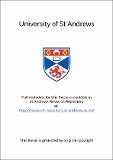Causes of individual variation in fasting fuel allocation and consequences for diving behaviour in grey seal pups (Halichoerus grypus)
Abstract
Grey seal pups are weaned abruptly after a short, intensive nursing period, during
which
they lay down fat and protein. Fat stores are crucial for insulation when they
first go to sea and protein is essential for muscle and oxygen store development. Both
components also provide them with energy to sustain them during an extended
postweaning fast and their first days and weeks at sea until they can forage
effectively. There is thus a trade off between the requirements for fat and protein in
metabolism and for other functions. It is crucial for the survival of grey seal pups that
they begin to feed before these reserves become critically depleted. The ability to do
so
depends on the size of their fat and protein stores at weaning, energy partitioning
during the postweaning fast and the development of adequate diving and foraging
capabilities. The management of fat and protein stores through energy partitioning
and
appropriate timing of departure are key to survival but the mechanism by which
this management is achieved is unknown.
To
investigate the mechanism that controls energy partitioning and timing of
departure from the colony, changes in body mass and composition and levels of
hormones that are involved in energy balance in other mammals were measured
during the postweaning fast of wild grey seal pups. The impact of initial energy
reserves and hormone levels on
energy use and departure was investigated directly, by
manipulation of energy reserves and hormone levels, using supplementary feeding
and hormone treatment. This is the first time such intervention studies have been
performed in wild fasting pups. The impact of the stress of repeated handling on
hormone levels and energy utilisation was also examined. The movement patterns and
development of maximum diving capabilities of pups after departure were
investigated using satellite telemetry.
Leptin was present in grey seal serum but could not be measured accurately using two
currently available immunoassays. Prolactin was not detected in postweaned pup
serum and was eliminated as a
potential candidate for control of fuel use and timing
of
departure from the colony. Cortisol and thyroid hormones (TH) were measured in
serum but Cortisol could not be measured in grey seal saliva.
Cortisol and TH are
potentially involved in energy expenditure and fuel partitioning
during fasting. Cortisol and total thyroxine levels decreased from weaning to midway through the fast. Both hormones increased in response to both natural and artificially
induced
changes in fuel availability. Dexamethasone, a potent Cortisol analogue,
caused a short-term increase in mass
loss, and induced reversible and short-lived
changes in Cortisol levels and immune function, but its impact on energy partitioning
was unclear. The effects of the
drug were not mediated through TH. There were no
changes in TH or Cortisol consistently associated with the timing of departure and
dexamethasone did not induce
departure. Neither hormone therefore seemed likely to
be involved
directly in the cue to leave the breeding colony. Handling regime did not
impact significantly on Cortisol secretion, TH levels or long-term fuel use in grey seal
pups.
Fatter animals, or those provided with additional food, relied more heavily on
fat to meet
energetic requirements than leaner pups. There was no difference in
energy partitioning between the sexes. Grey seal pups had a greater tolerance to
protein depletion than terrestrial mammals but may have reached critical protein
levels soon after
departure from the colony. They were therefore under considerable
pressure to begin to feed very soon after they have gone to sea, despite their extensive
fat reserves.
Pups showed marked inter-individual differences in movement patterns, which
were
very different from those of adults. Initially they undertook coastal movement,
but showed wide
dispersal from the colony within their first few months at sea. They
began to exhibit adult-like repeated trips from known haul-outs to discrete offshore
areas 4-5 months after
departure. They were able to reach almost all areas and depths
available in the North Sea, but were constrained in their ability to remain submerged,
in terms of dive duration, post-dive surface interval and percentage of time spent
diving over extended periods, compared with adults. Their maximum ability to remain
submerged when they first went to sea was related to the duration of the postweaning
fast and thus the
degree of development on land. In contrast, maximum diving
capabilities achieved during the first three months at sea did not vary substantially
between animals and increased with time since
departure, and were thus likely to be a
product of diving-induced development of oxygen stores and cardiovascular control.
Overall, larger body size and longer fast duration conferred increased diving
capabilities, which may present one mechanism for increased survivorship in bigger
animals.
Type
Thesis, PhD Doctor of Philosophy
Collections
Items in the St Andrews Research Repository are protected by copyright, with all rights reserved, unless otherwise indicated.

